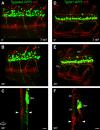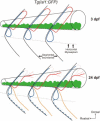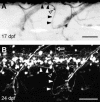Secondary motoneurons in juvenile and adult zebrafish: axonal pathfinding errors caused by embryonic nicotine exposure
- PMID: 19006183
- PMCID: PMC2798059
- DOI: 10.1002/cne.21903
Secondary motoneurons in juvenile and adult zebrafish: axonal pathfinding errors caused by embryonic nicotine exposure
Abstract
Nicotine is a drug of abuse that has been reported to have many adverse effects on the developing nervous system. We previously demonstrated that embryonic exposure to nicotine alters axonal pathfinding of spinal secondary motoneurons in zebrafish. We hypothesize that these changes will persist into adulthood. The Tg(isl1:GFP) line of zebrafish, which expresses green fluorescent protein (GFP) in a subtype of spinal secondary motoneurons, was used to investigate potential long-term consequences of nicotine exposure on motoneuron development. Anatomical characterization of Tg(isl1:GFP) zebrafish ranging between 3 and 30 days postfertilization (dpf) was initially performed in fixed tissue to characterize axonal trajectories in larval and juvenile fish. Tg(isl1:GFP) embryos were transiently exposed to 5-30 microM nicotine. They were then rescued from nicotine and raised into later stages of life (3-30 dpf) and fixed for microscopic examination. Morphological analysis revealed that nicotine-induced abnormalities in secondary motoneuron anatomy were still evident in juvenile fish. Live imaging of Tg(isl1:GFP) zebrafish using fluorescent stereomicroscopy revealed that the nicotine-induced changes in motoneuron axonal pathfinding persisted into adulthood. We detected abnormalities in 37-dpf fish that were transiently exposed to nicotine as embryos. These fish were subsequently imaged over a 7-week period of time until they were approximately 3 months of age. These pathfinding errors of spinal secondary motoneuron axons detected at 37 dpf persisted within the same fish until 86 dpf, the latest age analyzed. These findings indicate that exposure to nicotine during embryonic development can have permanent consequences for motoneuron anatomy in zebrafish.
Figures












Similar articles
-
Uncoupling nicotine mediated motoneuron axonal pathfinding errors and muscle degeneration in zebrafish.Toxicol Appl Pharmacol. 2009 May 15;237(1):29-40. doi: 10.1016/j.taap.2008.06.025. Epub 2008 Jul 23. Toxicol Appl Pharmacol. 2009. PMID: 18694773 Free PMC article.
-
Nicotinic receptors mediate changes in spinal motoneuron development and axonal pathfinding in embryonic zebrafish exposed to nicotine.J Neurosci. 2002 Dec 15;22(24):10731-41. doi: 10.1523/JNEUROSCI.22-24-10731.2002. J Neurosci. 2002. PMID: 12486166 Free PMC article.
-
Motoneuron axon pathfinding errors in zebrafish: differential effects related to concentration and timing of nicotine exposure.Toxicol Appl Pharmacol. 2015 Apr 1;284(1):65-78. doi: 10.1016/j.taap.2015.01.022. Epub 2015 Feb 8. Toxicol Appl Pharmacol. 2015. PMID: 25668718 Free PMC article.
-
Fishing for a deeper understanding of nicotine effects using zebrafish behavioural models.Prog Neuropsychopharmacol Biol Psychiatry. 2020 Mar 2;98:109826. doi: 10.1016/j.pnpbp.2019.109826. Epub 2019 Nov 26. Prog Neuropsychopharmacol Biol Psychiatry. 2020. PMID: 31783041 Review.
-
Zebrafish for the study of the biological effects of nicotine.Nicotine Tob Res. 2011 May;13(5):301-12. doi: 10.1093/ntr/ntr010. Epub 2011 Mar 8. Nicotine Tob Res. 2011. PMID: 21385906 Free PMC article. Review.
Cited by
-
Neurological Disorders Induced by Drug Use: Effects of Adolescent and Embryonic Drug Exposure on Behavioral Neurodevelopment.Int J Mol Sci. 2024 Jul 30;25(15):8341. doi: 10.3390/ijms25158341. Int J Mol Sci. 2024. PMID: 39125913 Free PMC article. Review.
-
A gradient in endogenous rhythmicity and oscillatory drive matches recruitment order in an axial motor pool.J Neurosci. 2012 Aug 8;32(32):10925-39. doi: 10.1523/JNEUROSCI.1809-12.2012. J Neurosci. 2012. PMID: 22875927 Free PMC article.
-
A genetic model of CEDNIK syndrome in zebrafish highlights the role of the SNARE protein Snap29 in neuromotor and epidermal development.Sci Rep. 2019 Feb 4;9(1):1211. doi: 10.1038/s41598-018-37780-4. Sci Rep. 2019. PMID: 30718891 Free PMC article.
-
A suitable anaesthetic protocol for metamorphic zebrafish.PLoS One. 2021 Mar 5;16(3):e0246504. doi: 10.1371/journal.pone.0246504. eCollection 2021. PLoS One. 2021. PMID: 33667238 Free PMC article.
-
Activation of α2A-containing nicotinic acetylcholine receptors mediates nicotine-induced motor output in embryonic zebrafish.Eur J Neurosci. 2014 Jul;40(1):2225-40. doi: 10.1111/ejn.12591. Epub 2014 Apr 17. Eur J Neurosci. 2014. PMID: 24738729 Free PMC article.
References
-
- Beattie CE, Hatta K, Halpern ME, Liu H, Eisen JS, Kimmel CB. Temporal separation in the specification of primary and secondary motoneurons in zebrafish. Dev Biol. 1997;187:171–182. - PubMed
-
- Bhatt DH, Otto SJ, Depoister B, Fetcho JR. Cyclic AMP-induced repair of zebrafish spinal circuits. Science. 2004;305:254–258. - PubMed
-
- Burns FR, von Kannen S, Guy L, Raper JA, Kamholz J, Chang S. DM-GRASP, a novel immunoglobulin superfamily axonal surface protein that supports neurite extension. Neuron. 1991;7:209–220. - PubMed
Publication types
MeSH terms
Substances
Grants and funding
LinkOut - more resources
Full Text Sources
Molecular Biology Databases
Research Materials
Miscellaneous

